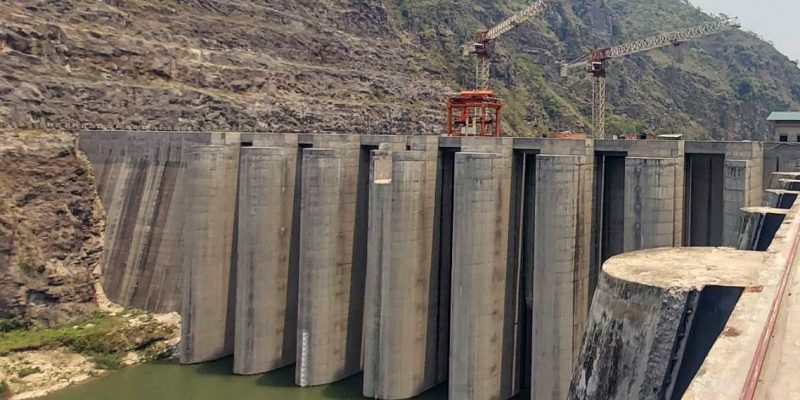In advance of its scheduled activation in October of this calendar year, Prime Minister of Bhutan Tshering Tobgay has initiated the preliminary reservoir filling of the India-sponsored 1,020 MW Punatsangchhu-II hydroelectric endeavor in Bhutan. This ceremonial act took place in the presence of Sudhakar Dalela, the Indian Ambassador to the Himalayan realm.
Also in attendance during the proceedings held on Wednesday were Gem Tshering, Bhutan’s Minister for Energy and Natural Resources, and Tandin Wangchuk, the chairman of the Punatsangchhu Hydroelectric Project Authority (PHPA), as reported by the PSU Connect news website.
The process of reservoir filling holds paramount significance in the conclusive phase of erecting a hydroelectric power plant. This procedure traditionally involves finalizing the closure of the river diversion scheme, instigating the functionality of discharge structures, and commencing operations at the powerhouse. The successful execution of these tasks marks the preparedness to commence power generation within the hydroelectric power plant.
The Punatsangchhu II stands as a run-of-the-river hydroelectric power generation facility situated in the Wangdue Phodrang district of Bhutan. The initiative is being orchestrated by the Punatsangchhu II Hydroelectric Project Authority (PHPA II) under an inter-governmental agreement between the Government of India and the Royal Government of Bhutan.
As outlined on the PHPA-II website, the venture was sanctioned with a financial allocation of Rs 37,778 million (base cost excluding interest during construction and March 2009 price level), boasting an installed capacity of 990 MW (later revised to 1,020 MW). The entire funding for this project emanates from the Government of India, comprising 30 percent as a grant and 70 percent as a loan component with an annual interest rate of 10 percent.
India’s Water and Power Consultancy Services (WAPCOS) played a pivotal role, providing engineering and design consultancy services during the project’s study phase, while the National Institute of Rock Mechanics (NIRM) was enlisted for modeling and geotechnical engineering services.
The initiation of the project’s construction dates back to December 2010, with an ambitious completion timeline of seven years, inclusive of two years allocated for infrastructure development. However, this initial deadline was not met, necessitating the establishment of a second deadline at the close of 2022. Unfortunately, this second target also proved elusive, leading to the final deadline for project commissioning being reset to October 2024.
The project is geographically located on the right bank of the Punatsangchhu river along the Wangdue-Tsirang highway, spanning a distance of 20 km to 35 km downstream of the Wangdue Bridge. The dam site is approximately 94 km from Thimphu along the highway, with the nearest airport in Paro situated about 125 km away. The nearest railway station at Hasimara on the Siliguri-Alipurduar Broad Gauge line of India’s Northeast Frontier Railway. Accessibility is also possible from Bagdogra Airport near Siliguri in West Bengal and via Phuentsholing-Semtokha (near Thimphu)–Dochula (about 440 km). The project area can also be approached from the proposed Gelephu smart city near the south-central border of Bhutan.
The Punatsangchhu river commences its journey at the confluence of the rivers Phochhu and Mochhu, standing at an altitude of approximately 1,200 meters above sea level at Punakha. The river then flows southerly, entering the Indian plains of West Bengal and ultimately merging into the Brahmaputra.
The diversion dam of the run-of-the-river Punatsangchhu-II hydroelectric project is strategically positioned about 20 km downstream of Wangduephodrang bridge. All other components of the project are situated on the right bank. The underground power house is situated 15 km downstream of the dam at Kamechu, Dagar Gewog (an administrative unit under a district in Bhutan).
The Punatsangchhu II hydroelectric project encompasses the erection of a concrete gravity dam, measuring 91 m in height and 223.8 m in length. Additionally, it involves the establishment of an 877.46 m-long diversion tunnel with a diameter of 12 m, capable of discharging 1118 cubic meters of water per second.
The project also integrates the construction of an upper cofferdam, measuring 168.75 m in length and 22 m in height, along with a downstream cofferdam having dimensions of 102.02 m in length and 13.5 m in height. The primary dam will be equipped with seven sluice gates, each measuring 8 m in width and 13.20 m in height.
The power plant will house an underground powerhouse, measuring 240.7 m in length, 23 m in width, and 51 m in height, hosting six units of 170 MW each.
According to Ramesh Kumar Chandel, the managing director of PHPA-II, two of these units will be prepared for commissioning by October 2024. The remaining four will be commissioned by the culmination of this year, as relayed to Bhutan’s Kuensel newspaper in August of the preceding year.
Upon reaching full operational capacity, the Punatsangchhu II hydroelectric project is anticipated to generate 4,357 million units of electricity annually. All surplus power generated from the project is slated for export to India.




